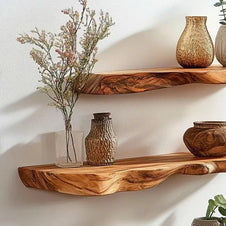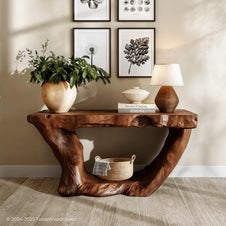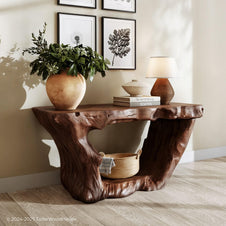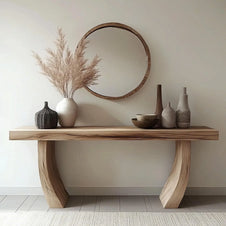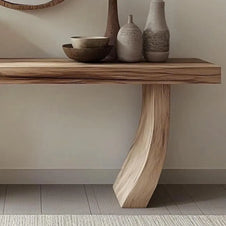The coffee table is a central piece that defines your living room, but choosing the right one is about more than just style. The wrong dimensions can disrupt the entire flow of your home, making a table feel too tall, too long, or too small for the space. This guide provides a strategic approach to avoid guesswork. It breaks down every key measurement - including height, length, width, and clearance - to help you determine the right average coffee table dimensions for your home. By using this checklist, you will have a clear system for making a confident choice, ensuring your new coffee table is a perfect fit for your lifestyle and your space.
The Average Coffee Table Dimensions
Before we dive into the details, it’s helpful to have a quick reference for the foundational numbers that guide a successful living room layout. These are the golden rules of proportion that designers swear by. The average coffee table dimensions are based on decades of ergonomic research and aesthetic principles, and they serve as an excellent starting point for any shopper.
Height
The standard range for height is typically between 16 and 18 inches. The most important rule to remember is that the table should be equal to or no more than 1-2 inches below your sofa's seat cushion. This ensures that items on the table are within a comfortable reach.
To find the perfect height, you must first measure your sofa. Use a tape measure to find the distance from the floor to the top of your sofa's seat cushion. It is crucial to measure the height of the cushion when it is slightly compressed, as this gives you a more realistic baseline for where you actually sit. With this number in hand, you can confidently shop for a table that is at most 1-2 inches shorter.
Length
A good rule of thumb is for the table's length to be approximately two-thirds the length of your sofa. This two-thirds rule for length is a powerful tool for achieving visual harmony in your living room. A table that is too short can look like an afterthought, while one that is too long can make the room feel cramped and unbalanced. This rule is simple to apply and works for almost any sofa size. For a standard 84-inch sofa, you should aim for a table around 56 inches long. For a smaller loveseat, a table closer to 30 inches would be ideal.
Width
The width of your coffee table is a crucial factor for a room's function and flow. While the average coffee table dimensions for width are 18-24 inches, you should adjust this based on your space. A narrower table works best in tight living rooms, preventing a cluttered feel, while a wider table is ideal for large, open rooms. The key is to balance the table's width with its length and clearances. This ensures your table provides the right amount of surface area without hindering comfortable movement.
Clearance
There are two key clearance measurements. Ensuring proper clearance allows for comfortable movement and a seamless flow in your living room.
-
18-inch Comfort Zone: This is the ideal distance between your sofa and the table, allowing you to comfortably reach for items without feeling cramped.
-
30-inch Traffic Path: Ensure there is at least 30 inches of clearance between the table and other furniture to allow for a clear walkway.
By considering both the table's measurements and these clearances, you can ensure your choice with the correct average coffee table dimensions enhances your room's flow rather than hindering it.
The golden rules for average coffee table dimensions - height, length, and clearance - are a great starting point. By understanding these principles, you can confidently choose a table that fits your space, such as this live edge coffee table.
Choosing a Shape to Complement Your Room
Beyond height, length, and width, the shape of your coffee table is a powerful design tool that can drastically alter the feel and function of your living room. The average coffee table dimensions for each shape vary, and choosing the right one can solve common design challenges.
-
Rectangular Tables: This is the most classic and common shape, and it pairs perfectly with a standard sofa. The average coffee table dimensions for a rectangle provide a large, predictable surface area that is both functional and aesthetically pleasing. A rectangular table is excellent for long, narrow rooms where it can complement the shape of the space.

For a simple solution, this rectangular live-edge coffee table is a perfect pick. It offers both standard dimensions and a unique, beautiful look.
-
Round Tables: A round table is a fantastic option for small living rooms, for rooms with lots of sharp corners, and especially for homes with children or pets. The lack of sharp edges makes it a safer choice, and its circular shape can soften a room's aesthetic. The average coffee table dimensions for a round table are typically measured by its diameter, and they are perfect for creating a sense of flow and intimacy.

A round coffee table offers unique benefits that can solve a variety of design and safety challenges.
-
Square Tables: A square table is the ideal solution for large sectionals and "L"-shaped seating arrangements. It fits perfectly into the corner of the sectional, creating a symmetrical and accessible centerpiece. The average coffee table dimensions for a square table should be chosen in relation to the overall size of the sectional's main seating area.
-
Nesting Tables: For smaller or multi-functional spaces, nesting tables are a highly versatile alternative to a single table with standard average coffee table dimensions. You can pull them apart for extra surface area when you have guests and tuck them away when you need more floor space. They offer the function of a coffee table without locking you into a single set of average coffee table dimensions.
Buying Tips: What to Look For
With your newfound knowledge of average coffee table dimensions, you are ready to shop with confidence. However, even with the right measurements, there are a few final steps you can take to ensure a perfect purchase.
-
The Spec Sheet: Never, ever trust a product photo alone. The perspective can be misleading, and a table that looks small online might be massive in your space. Always read the explicit height, width, and length specifications listed in the product description. This is the moment of truth for confirming if the table's average coffee table dimensions will work for you.
-
Mockups: Before you buy, create a physical mockup in your living room. Use painter's tape on the floor to outline the table’s length and width, and stack books or cardboard boxes to your target height. This simple exercise will allow you to see the table’s footprint and confirm that the chosen average coffee table dimensions are perfect.
-
Material and Style: While the focus of this guide is on dimensions, remember that the material and style of a table can significantly impact how it feels in a space. A chunky wooden table and a delicate glass table with the same average coffee table dimensions will have a very different visual weight.

When choosing a piece of furniture, it's not enough to just trust the numbers. A perfect fit for your home requires you to check the specs, create a mockup, and carefully consider the materials. Fortunately, this coffee table is designed to solve all of those problems for you.
Common Mistakes to Avoid When Selecting Coffee Table Size
Avoiding these common mistakes is crucial for a successful design:
-
Ignoring the Two-Thirds Rule: To get the average coffee table dimensions right, always measure your sofa first. A good rule of thumb is to choose a table that's approximately two-thirds its length, which ensures your space feels balanced and avoids a cluttered or mismatched look.
-
Forgetting About Traffic Flow: Even a table with the perfect length and height will feel wrong if you ignore the clearances. Always ensure there is 18 inches of space between the sofa and the table, and at least 30 inches for any main walkways.
-
Not Considering All Dimensions Together: It's easy to focus on one measurement at a time, but the true magic happens when all the dimensions work in harmony. The average coffee table dimensions for height, length, and width should all be considered simultaneously. A table with the right height but the wrong length will still throw off the balance of your room.
-
Relying on Photos Alone: Never trust a product photo alone, as online perspective can be misleading. Always verify the explicit height, width, and length specifications in the description to confirm the average coffee table dimensions and ensure the table will fit.
Final Thought
Choosing the right coffee table doesn't have to be a guessing game. By focusing on the key dimensions of height, length, width, and clearance, you can confidently select a table that fits your lifestyle and space perfectly. The right size will instantly transform your living room into a more balanced and comfortable area. Now that you have the tools to make that happen, the final step is to style your new table. Head to Pinterest for endless decorating ideas to make it your own.


